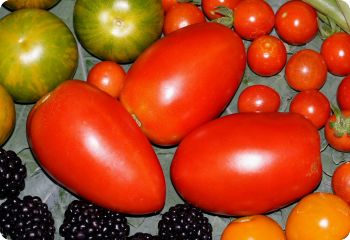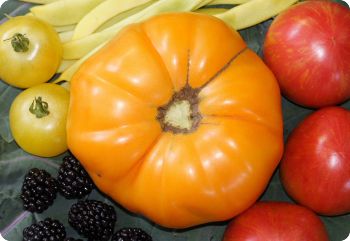Saving Tomato Seeds - Fermenting & Cleaning
by Diane Linsley
This article gives detailed instructions for saving tomato seeds, including fermenting and cleaning the seeds.
“What’s that strange smell?”
“Yuck! What stinks?”
“Oh, no! Mom is doing tomato seeds again.”
These are comments often heard at our house in August and September. The unusual odor wafting from the kitchen indicates that it’s the season for saving tomato seeds.
Most seeds are easy to save. They only need cleaning and drying. But saving tomato seeds involves an extra step: fermenting. It may seem complicated at first, but it’s actually quite easy (and not really as disgusting as it sounds).
Harvesting Tomato Seeds
You should only save seeds from open-pollinated or heirloom tomatoes. If you save seeds from hybrid tomatoes, their offspring won’t be true to type. All of the seeds sold on this website are open-pollinated or heirloom.
Even though tomatoes are mostly self-pollinated, the plants that you intend to save seeds from should be isolated by a distance of at least 6-10 feet from any other tomato varieties. This reduces the chances of cross-pollination. Plant other vegetables or flowers between groups of tomatoes to distract the bees.
Always save seeds from fully ripe tomatoes. Ideally, the tomatoes should be taken from 3-4 different plants of the same variety in order to maintain the slight genetic diversity found within a single variety. Don't save seeds from plants with inferior fruits.
Fermenting Tomato Seeds
Slice the tomato open, then squeeze out the seeds and juice, or run your thumb along the insides of the pockets of seeds to dislodge them. The seeds and juice will go into a plastic cup, and the leftover tomato flesh can be chopped up for salsa. So there’s no waste.
Label the cup with the name of the variety. I use a piece of paper stuck on with scotch tape. This label can be transferred to the drying plate later on. Set the cup on the kitchen countertop or outside in the garage. It typically takes 4-5 days for the seeds to ferment and separate from their gel capsules. Fermenting tomato seeds not only gives you nice, clean seeds, but it also kills any disease-causing microbes that might otherwise infect the next generation of tomato plants. And it improves the germination rate of the seeds.
It’s normal for a harmless, white mold to develop on the surface of the tomato liquid. You’ll know when the seeds are done fermenting when they separate and sink to the bottom of the cup when it is stirred. If you can’t tell, add some water to the cup and stir again. If the seeds are stuck in their gel capsules, they need to ferment longer.
Cleaning Tomato Seeds
When the seeds are done fermenting, add water to almost fill the cup. Stir for several seconds, then allow the good seeds to sink (bad seeds will float). Pour off most of the liquid, add more water, then stir again. Continue this process until the seeds are free of all debris. Pour off all the water, using your fingers to block the seeds from falling out of the cup.
Spread the wet seeds on a paper plate (to absorb moisture) or on a piece of window screen material laid over the top of a regular plate. Spread the seeds around so they will dry quickly. After the first 24 hours, separate the seeds that are stuck together.
Air dry the seeds for 3 weeks, or until a seed broken in half with your fingers makes a faint snapping noise. Seeds that bend instead of snap need to be dried longer. Store the seeds in an airtight container in a cool, dry, dark place like a basement closet or a refrigerator. Properly stored seed should be viable for 5 years or more.
Saving seeds is as much a part of gardening as planting and harvesting. Even though my kids aren't thrilled by the smell of fermenting tomatoes, they can’t help being fascinated by the process of fermentation and the life cycle of plants.
Related Articles
Saving Flower Seeds - Learn new tricks for saving flower seeds.
Starting Seeds Indoors - How to start tomato seeds indoors.
Recommended Books
100 Heirloom Tomatoes for the American Garden by Carolyn J. Male
Seeds

